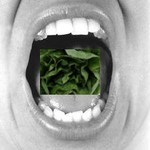Where the Wild Things Are
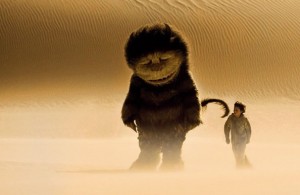 I really can’t draw. If there was ever proof of this, it was in college when I was taking a video production course and amongst all of the other little things that went into the writing, editing, directing, and organizational elements, we had to do storyboards. It is wishful thinking on a student production that you’re going to even use your storyboards anyway, you’d be lucky to get shots that cut together at all, let alone that follow predetermined images. Our professor told us that we were not allowed to draw stick figures; if we didn’t have any ability to draw we had to draw blobby people. When he described a blobby person, he held up a wooden figure with various joints connected by string that was loose enough to flop around. They kind of looked like one of the monsters in Big Man Japan, but in my head I always thought of blobby people* as a lumpy, shapeless Grimace type, kind of like this.
I really can’t draw. If there was ever proof of this, it was in college when I was taking a video production course and amongst all of the other little things that went into the writing, editing, directing, and organizational elements, we had to do storyboards. It is wishful thinking on a student production that you’re going to even use your storyboards anyway, you’d be lucky to get shots that cut together at all, let alone that follow predetermined images. Our professor told us that we were not allowed to draw stick figures; if we didn’t have any ability to draw we had to draw blobby people. When he described a blobby person, he held up a wooden figure with various joints connected by string that was loose enough to flop around. They kind of looked like one of the monsters in Big Man Japan, but in my head I always thought of blobby people* as a lumpy, shapeless Grimace type, kind of like this.
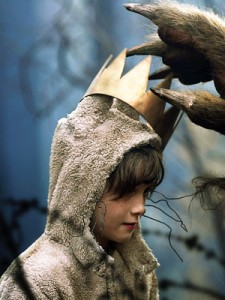 Blobby people are what I thought of while watching Spike Jonze’s adaptation of Where the Wild Things Are, where the creatures that a young boy, Max who has run away from home has imagined, are lumpy, odd looking, and unnerving, if not exactly scary (think Lidsville, but in the desert). Their lips, which perfectly match up with the celebrity-voiced dialogue (well cast celebrities at that, especially James Gandolfini as Carol, the impulsive, short tempered monster, and Chris Cooper as Ira, a soft-spoken, pale version of the San Diego Chicken) combined with the large heads of the puppets have a feel unlike any other movie other than The Neverending Story. And unlike that Wolfgang Petersen film (and presumably the novel it was based on, I haven’t read it), Jonze doesn’t wallow in condescending messages, and doesn’t guide us through the story point by point.
Blobby people are what I thought of while watching Spike Jonze’s adaptation of Where the Wild Things Are, where the creatures that a young boy, Max who has run away from home has imagined, are lumpy, odd looking, and unnerving, if not exactly scary (think Lidsville, but in the desert). Their lips, which perfectly match up with the celebrity-voiced dialogue (well cast celebrities at that, especially James Gandolfini as Carol, the impulsive, short tempered monster, and Chris Cooper as Ira, a soft-spoken, pale version of the San Diego Chicken) combined with the large heads of the puppets have a feel unlike any other movie other than The Neverending Story. And unlike that Wolfgang Petersen film (and presumably the novel it was based on, I haven’t read it), Jonze doesn’t wallow in condescending messages, and doesn’t guide us through the story point by point.
Where the Wild Things Are is messy, repetitive, beautiful, ugly, drawn out, and underdeveloped, and considering the monsters all represent various parts of the Max’s personality (caring, insecure, sensitive, adventurous, lonely, frustrated, etc.), that’s exactly how it should be. As soon as he enters their realm, they dub him king (since that’s what he tells them he is), but expect him to tell them how to be happy, as they have devolved into complete insecurity and destruction. Jonze’s own childlike view of the world (especially evident in his music videos) makes it obvious that he sees Max as his surrogate, and just as Jonze would, he has Max make suggestions to the monsters, such as building forts and hideouts, and playing games of where everyone throws dirt at each other, but doesn’t order them around, letting them figure out on their own what they excel at. This was true in Jonze’s first two features, Being John Malkovich and Adaptation, which had plenty within Charlie Kaufman’s scripts to direct the way. Jonze’s ethos boils down to a clichéd tough guy question: If he was asked to “lead, follow, or get out of the way,” Jonze would get out of the way. He doesn’t show off and his choice to once again drain the color from the film and use hand-held camera amidst the surreal (especially effective in grounding the human relationships in Being John Malkovich and not letting the bizarre concept be the whole movie) is what gives Where the Wild Things Are a strange naturalism different from all other films that tend to be aimed at children.
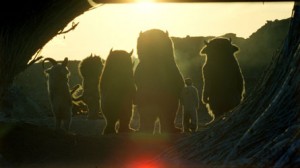 The movie is in some way more of an achievement than the Kaufman scripts that Jonze adapted, because he, along with co-writer Dave Eggers, had far less to work with in Where the Wild Things Are, as Maurice Sendak’s book is so short and concise. Their decision making seemed to have revolved around not trying to overload us with too much of anything (well, except those numerous music-accompanied running sequences). The movie is downbeat and occasionally sad, it’s funny, but not hilarious (“sorry we were going to eat you, we didn’t realize you were king”), the imagery can be striking, such as the enormous castle that looks like Weird Al’s The Biggest Ball of Twine in Minnesota, but it isn’t overwhelming, staying with the dusty brown look, and it’s dreamlike, such as the Jonah and the Whale sequence, but never betrays the reality it has created. In that way, Where the Wild Things Are is a movie that seems the most in touch with the way a child’s mind works in any film since the crazy nonsense of Spy Kids 2. Whatever your reaction is to Where the Wild Things Are, and all credit to Jonze for convincing Warner Brothers to finance it, it’s not easily summed up or simplified, unless being told that monsters punching holes in trees entices you enough. Who could hate that?
The movie is in some way more of an achievement than the Kaufman scripts that Jonze adapted, because he, along with co-writer Dave Eggers, had far less to work with in Where the Wild Things Are, as Maurice Sendak’s book is so short and concise. Their decision making seemed to have revolved around not trying to overload us with too much of anything (well, except those numerous music-accompanied running sequences). The movie is downbeat and occasionally sad, it’s funny, but not hilarious (“sorry we were going to eat you, we didn’t realize you were king”), the imagery can be striking, such as the enormous castle that looks like Weird Al’s The Biggest Ball of Twine in Minnesota, but it isn’t overwhelming, staying with the dusty brown look, and it’s dreamlike, such as the Jonah and the Whale sequence, but never betrays the reality it has created. In that way, Where the Wild Things Are is a movie that seems the most in touch with the way a child’s mind works in any film since the crazy nonsense of Spy Kids 2. Whatever your reaction is to Where the Wild Things Are, and all credit to Jonze for convincing Warner Brothers to finance it, it’s not easily summed up or simplified, unless being told that monsters punching holes in trees entices you enough. Who could hate that?
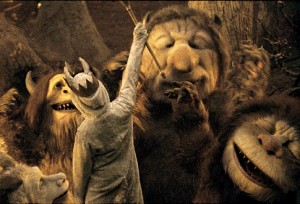 * I would have been happy to draw blobby people, if I could, but I’m really not even close. I was making a silly music video about a spazzy-dancing clueless guy who accidentally picks up a hooker (a pimp trips him with his cane while the guy bounces around an undesirable alley) and brings her back to his dorm room where he insists that instead of sex, they play paddy cake. I was too concerned with having the story make sense, rather than worrying about spending 3 hours drawing completely unintelligible scrawl. So I shot the video first and then had a more artistically-inclined friend draw the storyboards afterwards based on my descriptions.
* I would have been happy to draw blobby people, if I could, but I’m really not even close. I was making a silly music video about a spazzy-dancing clueless guy who accidentally picks up a hooker (a pimp trips him with his cane while the guy bounces around an undesirable alley) and brings her back to his dorm room where he insists that instead of sex, they play paddy cake. I was too concerned with having the story make sense, rather than worrying about spending 3 hours drawing completely unintelligible scrawl. So I shot the video first and then had a more artistically-inclined friend draw the storyboards afterwards based on my descriptions.



